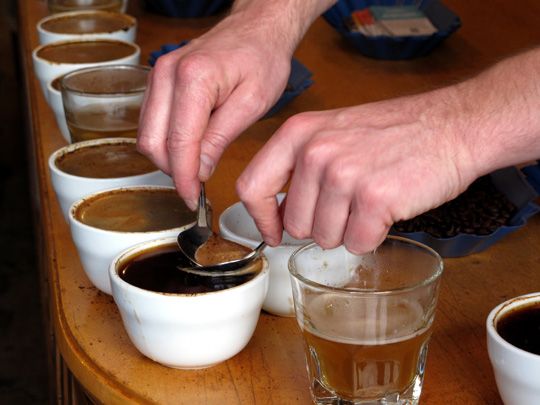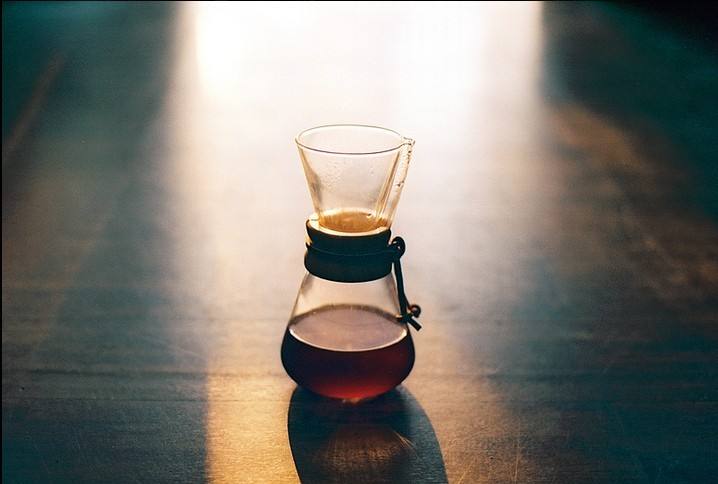What is a cup test? Introduction to cup testing learning
Follow the caf é (Wechat official account vdailycom) and found that Beautiful Cafe opened a small shop of its own.
Coffee cup test, English called coffee cupping, also known as coffee tasting. Popular saying is to use a special brewing method to taste coffee. When testing a cup of coffee, we should distinguish whether the flavor, alcohol thickness, acidity and wet aroma of the coffee are pleasant. Most cup tasters use the following criteria to judge coffee.
While tasting the coffee, you should try to discern whether the flavor, body, acidity and aroma of the coffee is pleasant, or unpleasant. Here are the criteria that most tasters use to judge coffee.
Acidity Acidity:
Acidity is an essential feature of coffee and is the feeling of dryness that coffee produces at the edge of the tongue and the back of the palate. The effect of coffee acidity is similar to that of red wine, with a strong and exciting texture. Without enough acidity, the coffee tends to be flat. Acidity is different from sour taste, which is an unpleasant and bad taste feature.
Acidity is a desirable characteristic in coffee. It is the sensation of dryness that the coffee produces under the edges of your tongue and on the back of your palate. The role acidity plays in coffee is not unlike its role as related to the flavor of wine. It provides a sharp, bright, vibrant quality. With out sufficient acidity, the coffee will tend to taste flat. Acidity should not be confused with sour, which is an unpleasant, negative flavor characteristic.

Wet aroma Aroma
The wet aroma is difficult to separate from the flavor. If there is no sense of smell, our basic sense of taste is only sweet, sour, salty and bitter. The wet aroma enriches the taste discrimination of the soft palate. Some subtle and delicate differences, such as the "floral" or "wine" characteristics, come from the wet aroma of brewed coffee.
Aroma is a sensation which is difficult to separate # flavor. Without our sense of smell, our only taste sensations would be: sweet, sour, salty, and bitter. The aroma contributes to the flavors we discern on our palates. Subtle nuances, such as "floral" or "winy" characteristics, are derived # the aroma of the brewed coffee.
Alcohol thickness Body:
Alcohol thickness is the feeling of coffee in the mouth, that is, the feeling of stickiness, thickness and richness produced by coffee acting on the tongue. The difference between drinking whole milk and drinking water is a good example. Our perception of the alcohol thickness of coffee is related to the oil and solids extracted by coffee. The alcohol thickness of Indonesian coffee is significantly higher than that of South and Central American coffee. If you are not sure about the alcohol thickness difference of several types of coffee, try adding the same amount of milk to the coffee. Coffee with high alcohol thickness will retain more flavor when diluted with milk.
Bodyis the feeling that the coffee has in your mouth. It is the viscosity, heaviness, thickness, or richness that is perceived on the tongue. A good example of body would be that of the feeling of whole milk in your mouth, as compared to water. Your perception of the bodyof a coffee is related to the oils and solids extracted during brewing. Typically, Indonesian coffees will possess greater body than South and Central American coffees. If you are unsure of the level of body when comparing several coffees, try adding an equal amount of milk to each. Coffees with a heavier body will maintain more of their flavor when diluted.
Flavor Flavor:
Flavor is the overall feeling of coffee in the mouth. Acidity, wet aroma and alcohol thickness are all components of flavor, and it is their balance and homogenization that produce our overall sense of flavor. Here are some typical flavor features:
Flavor is the overall perception of the coffee in your mouth. Acidity, aroma, and bodyare all components of flavor. It is the balance and homogenization of these senses that create your overall perception of flavor. The following are typical flavor characteristics:
General flavor characteristics General flavor characteristics:
Richness-refers to the thickness and richness of alcohol
Complexity-the feeling of multiple flavors
Balance-all basic palate features are satisfactory, and no one taste masks the other.
Richness-refers to bodyand fullness
Complexity- the perception of multiple flavors
Balance- the satisfying presence of all the basic taste characteristics where no one over-powers another
Pleasing flavor features:
Fresh, bright, dry, light, or lively-(common in Central American coffee):
Caramel-like sugar or syrup
Chocolate-like unsweetened chocolate or vanilla aftertaste
Delicious-delicate flavor felt on the tip of the tongue (Arabica beans from New Guinea)
Earthy-the aroma of the earth (typical Sumatran coffee)
Fragrant-an aromatic quality, ranging from floral to spicy
Fruity-an aromatic quality reminiscent of berries or oranges
Sweet and mellow-round, smooth, lack of acidity
Nutty-- similar to the aftertaste of fried nuts
Spicy-reminiscent of the flavor and aroma of various spices
Sweet-- non-astringent
Wild-A wild flavor that is not generally considered pleasant; common in Ethiopian coffee
Alcoholic aroma-an aftertaste reminiscent of fully ripe wines (common in Kenyan and Yemeni coffee).
Typical specific desirable flavor characteristics:
Bright, Dry, Sharp, or Snappy- (typical of Central American coffees)
Caramelly-candy like or syrupy
Chocolaty- an aftertaste similar to unsweetened chocolate or vanilla
Delicate- a subtle flavor perceived on the tip of the tongue (typical of washed New Guinea arabica)
Earthy- a soily characteristic (typical of Sumatran coffees)
Fragrant- an aromatic characteristic rangingf romfloral to spicy
Fruity- an aromatic characteristic reminiscent of berries or citrus
Mellow- a round, smooth taste, typically lacking acid
Nutty- an aftertaste similar to roasted nuts
Spicy- a flavor and aroma reminiscent of spices
Sweet- free of harshness
Wildness- a gamey flavor which is not usually considered favorable but is typical of Ethiopian coffees
Winy- an aftertaste reminiscent of well-matured wine (typical of Kenyan and Yemeni coffees).
An unpleasant flavor feature:
Bitter-A taste produced at the root of the tongue, often caused by overbaking
Dull, non-irritating-neutral in flavor
Charcoal-smelling of charred carbon
Inanimate-- same as "Flat"
Mixed-smelling-musty, reminiscent of the taste of eating dirt
Earthy-- with "mixed smell"
Insipid-no sour taste, lack of wet fragrance and aftertaste
Grassy-reminiscent of freshly cut grass
Rough-- a harsh, catch-like, rough quality
Muddy-sticky but not strong in taste
Stiff-starch resembles texture, similar to water cooked with pasta
Rough-the feeling on the tongue, similar to eating salt
Rubber smell-similar to the smell of burnt rubber (commonly found in dry processed robusta beans)
Soft-the same as "boring, non-irritating"
Sour-similar to the sour taste of unripe fruit
Thin-acidity-free, usually caused by insufficient extraction
Turpentine-- tastes like turpentine.
Water-like-lack of alcohol thickness and stickiness in the mouth
Rough-wild quality.
Typical specific undesirable flavor characteristics:
Bitter- perceived on the back of the tongue, usually a result of over roasting
Bland- neutral in flavor
Carbony- burnt charcoaly overtones
Dead- see "flat"
Dirty- a mustiness reminiscent of eating dirt
Earthy- see "dirty"
Flat- lack of acidity, aroma, and aftertaste
Grassy- an aroma and flavor reminiscent of freshly cut lawn
Harsh- a caustic, clawing, raspy characteristic
Muddy- thick and dull
Rioy- a starchy texture similar to water which pasta has been cooked in
Rough- a sensation on the tongue reminiscent of eating salt
Rubbery- an aroma and flavor reminiscent of burnt rubber (typically found only in dry-processed robustas)
Soft- see "bland"
Sour- tart flavors reminiscent of unripe fruit
Thin- lacking acidity, typically a result of under brewing
Turpeny- turpentine-like in flavor
Watery- a lack of bodyor viscosity in the mouth
Wild- gamey characteristics.
[related reading]
Eight principles for judging Coffee by Cup timing
The first principle: [clean], clean when light, and clean when strong.
It's like a room, it's easy to be clean when it's empty, but it has to be clean when it's full.
The second principle: [spindle flavor], that is, it represents the characteristics of this region. Cleanliness is the foundation, and an unclean cup of coffee represents a flaw, but clean coffee can easily become tasteless, so it must have a main flavor. The taste of this spindle is from hot to cold, any cooking method, any baking degree. No shallow baking, no deep baking or no shallow baking, and the same is true of cooking.
The third principle: [location], if there is a taste, there must be a place. If you say there is a smell of wild flowers, please mark the location of the smell. If it cannot be marked, then the taste may only be a written description of the cup test report. It's just your imagination.
The fourth principle [moving path], the smell will not just be fixed in a certain position, the taste will move. If it is fixed in a certain position, then the smell is dead, and if it is the same from beginning to end, it is also dead. Good coffee is alive and leaves a foot in every place where it feels.
The fifth principle-[hierarchy]. [layer] is hierarchical arrangement, [times] is orderly. It's an orderly arrangement. [hierarchy] includes at least 8 categories. Thickness, depth, weight, strength, thickness, width, rigidity and softness. Sticky thin
The sixth principle [richness and complexity], the so-called [richness]-the rich are more beautiful, and the rich are more beautiful, which refers to [sufficient and beautiful taste], [complexity], heavy repetition and chaos, which means [similar and messy taste]. All the good tastes are called rich, and the five tastes are called complex.
The seventh principle-texture, the so-called texture refers to-temperament, personality, texture, touch and so on. If you use the analogy of cloth, it will be more clear-silk, Luo, silk, satin, silk, velvet, cotton, hemp, cashmere, wool, acrylic cloth, polyester fiber, etc., different materials have different texture personality. it also distinguishes advanced, ordinary, gorgeous, simple, elegant, rough and so on.
The eighth principle-[coordination], the so-called "coordination" means that there is a day and an earth, a front and a back, a top and a bottom, a head and a tail, a left and a right.
Important Notice :
前街咖啡 FrontStreet Coffee has moved to new addredd:
FrontStreet Coffee Address: 315,Donghua East Road,GuangZhou
Tel:020 38364473
- Prev

What is coffee extraction? Explain coffee extraction by mathematical method
We want to verify this in a quantifiable way. Lee said. In the future, we will not say: coffee powder has to be ground a little thicker, but will say: my coffee powder particle size should be XX. Through complex mathematical calculations, scientists have fully explained the mystery of coffee extraction for us. With their help, we can rush more accurately and scientifically in our daily life.
- Next

If you want to be a barista, you should set your dream as a goal.
Following Cafe Review (Wechat official account vdailycom) found that everyone who loves coffee will want to open a coffee shop of his own, and I believe you who are reading this article are no exception. At that time, I didn't have the concept of the word barista, and I didn't know about the third wave of boutique coffee craze. But as soon as I think about it
Related
- What is the meaning of lactic acid fermentation with coffee bean treatment?
- How to judge the state of foam by sound?
- How does the latte pull out the unicorn pattern? Come to get for a little trick to improve the flower pull!
- Will flower pulling affect the taste of the latte?
- Do you know the history of coffee?
- The difference between honey treatment and sun washing what is raisin honey treatment?
- What kind of milk can a novice use to make coffee foam to keep the foam longer? The correct method and skills of milking tutorial sharing
- Why do washed coffee beans taste sour? Flavor characteristics of washed Coffee
- Introduction to the skill of how to practice the size and height of water injection around the circle of hand-brewed coffee
- How do beginners practice coffee flower drawing from scratch?

